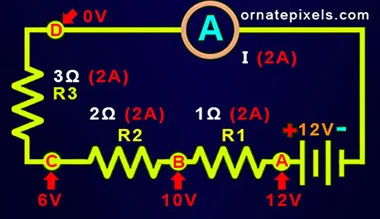Calculation of Resistance, Volt, Current, and Ohm according to Ohm's Law and Voltage Divider Formula What is a voltage divider? What does voltage divider work in electronic circuits, and how does it work?
That divides a voltage into smaller fractions or portions. It consists of two or more resistors connected in series, and it is commonly used in electronic circuits for various purposes, such as setting reference voltages, biasing transistors, or providing a specific voltage level for a particular component. Below is a general list of other uses of a voltage divider circuit.
A voltage divider is a simple electronic circuit. The basic principle of a Voltage divider is Ohm's Law (V= I × R). So, to make a voltage divider circuit, you must know how to calculate voltage, resistance, and current according to Ohm's law. It is implied that the voltage (V) applied across a resistor (R) equals the current (I) flowing through that resistor:
 |
Ohm's Law Calculation |
Look at Figure 1, where R is a resistor, V is voltage, and I is current, whose unit is A or ampere. Figure 2. In this circuit, 1 volt is applied across a 1 ohm resistor, and an ammeter is connected to measure the current flowing through the resistor. Look carefully at the circuit; 1 volt is supplied to a 1-ohm resistor, and 1-ampere current flows through the resistor. So, it is proved that when a Circuit has a resistance of 1 ohm and a current of 1-ampere flows, it must be ensured that 1 volt is applied to that circuit, Which corresponds to Ohm's Law.
Red light two times blinks problem solution for Sony Bravia TV. Click Here ]
V = IR (Ohm's Law).
When voltage is applied to a circuit of two or more resistors in series, the same current flows through each resistor. Therefore, the voltage across each resistor is directly proportional to its resistance. Take some time and try to understand the details in the image below.
 |
Ohm's Law: Volt, Resistance, and Current Calculation |
Ohm's Law of Voltage, Current, and Ampere- V = IR, I = V/R, R = V/I
Voltage Divider
The formula for determining the output voltage of a voltage (Vout) divider in a series circuit of two resistors. R1 and R2, connected in series is:
Vout = Vin × (R2 ÷ (R1 + R2)
Where-
• Vout is the output voltage (desired voltage)
• Vin is the input voltage (the voltage you want to divide).
• R1 is the resistance of the first resistor in the series circuit
• R2 is the resistance of the second resistor in that series circuit.
Choosing specific values for R1 and R2 can create a voltage divider circuit that produces the desired output voltage. A voltage divider is commonly used in electronics to provide a reference voltage for analog sensors, create bias voltages for transistors, or scale down voltage levels for input to microcontrollers and other components.
[ According to the Voltage Divider Formula-
R2 = (Vout × R1) ÷ (Vin - Vout)
Where is the voltage divider circuit used?
1. Voltage divider circuit of gamma section of LCD TV panel.
2. Setting reference voltages for sensors and analog circuits.
3. Biasing transistors in amplifiers and various electronic circuits.
4. Providing feedback in operational amplifier (op-amp) circuits.
5. Measuring unknown voltages by comparing them to a known reference voltage.
6. Creating a fixed output voltage from a variable input voltage.
7. Current sensor circuit.
8. Incorrect voltage detection circuit.
9. Overload protection circuit.
10. Overvolt and under-volt protection and detection circuit.
SM4186 IC Schematic Circuit- Click Here
More posts on resistors: This Series-Parallel calculator is great for calculating the total resistance of multiple resistors connected in series or parallel. The formulas for series and parallel are published here.





1 comment:
Understanding how voltage dividers work can make a huge difference in designing and troubleshooting circuits. If you're feeling a bit lost with the formulas and their uses, a can help clarify how to apply these concepts effectively.
Post a Comment